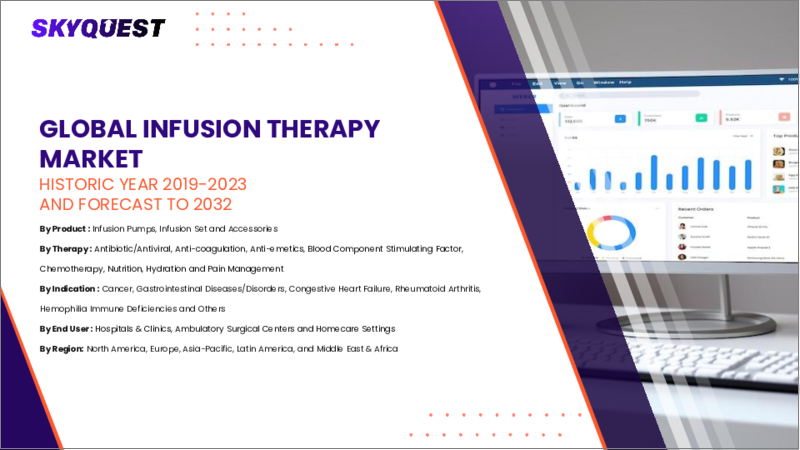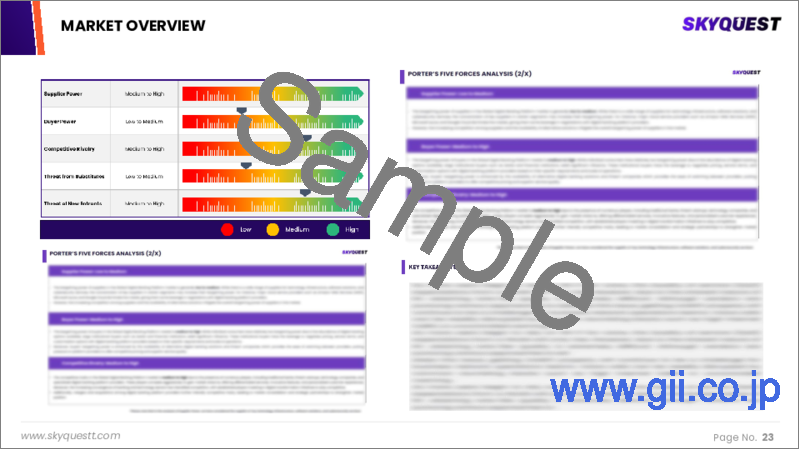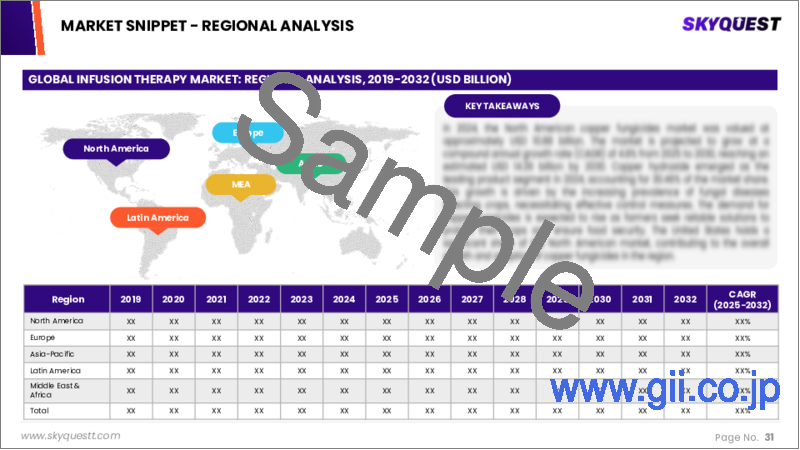|
|
市場調査レポート
商品コード
1630673
輸液療法市場規模、シェア、成長分析、製品別、適応症別、治療法別、用途別、エンドユーザー別、地域別- 産業予測、2025-2032年Infusion Therapy Market Size, Share, Growth Analysis, By Product (Infusion Pumps, Infusion Set), By Indication (Cancer, Gastrointestinal Diseases/Disorders), By Therapy, By Application, By End-user, By Region - Industry Forecast 2025-2032 |
||||||
|
|||||||
| 輸液療法市場規模、シェア、成長分析、製品別、適応症別、治療法別、用途別、エンドユーザー別、地域別- 産業予測、2025-2032年 |
|
出版日: 2025年01月09日
発行: SkyQuest
ページ情報: 英文 157 Pages
納期: 3~5営業日
|
全表示
- 概要
- 目次
輸液療法の世界市場規模は2023年に444億5,000万米ドルと評価され、2024年の474億3,000万米ドルから2032年には796億8,000万米ドルに成長し、予測期間(2025-2032年)のCAGRは6.7%で成長する見通しです。
世界の輸液療法市場は、人口の高齢化と慢性疾患の有病率の上昇に後押しされ、大幅な成長を遂げています。輸液や薬剤を血流に直接送り込むこの治療法は、特に抗生物質や化学療法、栄養補給などに迅速で効果的な治療を提供します。患者にとっては、正確な投与と薬効の延長という利点があり、投与回数が減り、外来や在宅での治療が可能になります。その利点にもかかわらず、輸液療法には感染や副作用などのリスクがあり、熟練した管理が必要となります。輸液デバイスの技術的進歩や在宅ヘルスケアへの需要の高まりは、市場拡大を推進する上で極めて重要です。全体として、輸液療法市場は、効率的なヘルスケアソリューションに対するニーズの高まりに対応し、成長態勢を維持しています。
目次
イントロダクション
- 調査の目的
- 調査範囲
- 定義
調査手法
- 情報調達
- 二次データと一次データの方法
- 市場規模予測
- 市場の前提条件と制限
エグゼクティブサマリー
- 世界市場の見通し
- 供給と需要の動向分析
- セグメント別機会分析
市場力学と見通し
- 市場概要
- 市場規模
- 市場力学
- 促進要因と機会
- 抑制要因と課題
- ポーターの分析
主な市場の考察
- 重要成功要因
- 競合の程度
- 主な投資機会
- 市場エコシステム
- 市場の魅力指数(2024年)
- PESTEL分析
- マクロ経済指標
- バリューチェーン分析
- 価格分析
輸液療法市場規模:製品別
- 市場概要
- 輸液ポンプ
- 携帯型輸液ポンプ
- 据置型輸液ポンプ
- シリンジ輸液ポンプ
- 使い捨てポンプ
- 大容量ポンプ
- エラストマーポンプ
- 輸液セット
- アクセサリー
輸液療法市場規模:適応症別
- 市場概要
- がん
- 消化器疾患/障害
- うっ血性心不全
- 関節リウマチ
- 血友病
- 免疫不全
- その他
輸液療法市場規模:治療法別
- 市場概要
- 抗生物質/抗ウイルス剤
- 抗凝固薬
- 制吐剤
- 血液成分刺激因子
- 化学療法
- 栄養
- 水分補給
- 疼痛管理
輸液療法市場規模:用途別
- 市場概要
- 化学療法
- 糖尿病
- 消化器疾患
- 疼痛管理
- その他
輸液療法市場規模:エンドユーザー別
- 市場概要
- 病院
- 外来手術センター
- クリニック
- ホームケア施設
輸液療法市場規模
- 北米
- 米国
- カナダ
- 欧州
- ドイツ
- スペイン
- フランス
- 英国
- イタリア
- その他欧州地域
- アジア太平洋地域
- 中国
- インド
- 日本
- 韓国
- その他アジア太平洋地域
- ラテンアメリカ
- ブラジル
- その他ラテンアメリカ地域
- 中東・アフリカ
- GCC諸国
- 南アフリカ
- その他中東・アフリカ
競合情報
- 上位5社の比較
- 主要企業の市場ポジショニング(2024年)
- 主な市場企業が採用した戦略
- 市場の最近の動向
- 企業の市場シェア分析(2024年)
- 主要企業の企業プロファイル
- 会社概要
- 製品ポートフォリオ分析
- セグメント別シェア分析
- 収益の前年比比較(2022-2024)
主要企業プロファイル
- Option Care Health Inc.(United States)
- Baxter International Inc.(United States)
- ICU Medical, Inc.(United States)
- B. Braun Melsungen AG(Germany)
- Terumo Corporation(Japan)
- Moog Inc.(United States)
- Fresenius SE & Co. KGaA(Germany)
- Smiths Medical(United Kingdom)
- JMS Co. Ltd.(Japan)
- Caesarea Medical Electronics(Israel)
- CareFusion Corporation(United States)
- Poly Medicure Limited(India)
- Nipro Corporation(Japan)
- Medtronic plc(Ireland)
- Becton, Dickinson and Company(BD)(United States)
- 3M Company(United States)
- Teleflex Incorporated(United States)
- Edwards Lifesciences Corporation(United States)
- Coloplast A/S(Denmark)
- Convatec Group plc(United Kingdom)
結論と推奨事項
Global Infusion Therapy Market size was valued at USD 44.45 billion in 2023 and is poised to grow from USD 47.43 billion in 2024 to USD 79.68 billion by 2032, growing at a CAGR of 6.7% during the forecast period (2025-2032).
The global infusion therapy market is witnessing substantial growth, fueled by an aging population and the rising prevalence of chronic diseases. This therapy, which involves the direct delivery of fluids and medications into the bloodstream, provides rapid and effective treatment, particularly for antibiotics, chemotherapy, and nutritional support. Patients benefit from precise dosing and prolonged medication effects, reducing the frequency of administration and enabling outpatient or home treatment options. Despite its advantages, infusion therapy presents risks, including infection and side effects, necessitating skilled administration. Technological advancements in infusion devices and the growing demand for home healthcare are pivotal in driving market expansion. Overall, the infusion therapy market remains poised for growth, addressing the increasing needs for efficient healthcare solutions.
Top-down and bottom-up approaches were used to estimate and validate the size of the Global Infusion Therapy market and to estimate the size of various other dependent submarkets. The research methodology used to estimate the market size includes the following details: The key players in the market were identified through secondary research, and their market shares in the respective regions were determined through primary and secondary research. This entire procedure includes the study of the annual and financial reports of the top market players and extensive interviews for key insights from industry leaders such as CEOs, VPs, directors, and marketing executives. All percentage shares split, and breakdowns were determined using secondary sources and verified through Primary sources. All possible parameters that affect the markets covered in this research study have been accounted for, viewed in extensive detail, verified through primary research, and analyzed to get the final quantitative and qualitative data.
Global Infusion Therapy Market Segmental Analysis
Global Infusion Therapy Market is segmented by Product, Indication, Therapy, Application, End-user and region. Based on Product, the market is segmented into Infusion Pumps, Infusion Set and Accessories. Based on Indication, the market is segmented into Cancer, Gastrointestinal Diseases/Disorders, Congestive Heart Failure, Rheumatoid Arthritis, Hemophilia, Immune Deficiencies and Others. Based on Therapy, the market is segmented into Antibiotic/Antiviral, Anti-coagulation, Anti-emetics, Blood Component Stimulating Factor, Chemotherapy, Nutrition, Hydration and Pain Management. Based on Application, the market is segmented into Chemotherapy, Diabetes, Gastrointestinal Diseases, Pain management and Others. Based on End-user, the market is segmented into Hospitals, Ambulatory Surgical Centers, Clinics and Homecare Settings. Based on region, the market is segmented into North America, Europe, Asia Pacific, Latin America and Middle East & Africa.
Driver of the Global Infusion Therapy Market
The global infusion therapy market is significantly driven by the rising incidence of chronic illnesses, including cancer, diabetes, and cardiovascular diseases. As these health conditions continue to affect a larger portion of the population, the need for effective treatment options, particularly in the form of infusion therapy products and services, has surged. This growing demand is prompting healthcare providers to expand their infusion therapy offerings, leading to innovations and advancements in technology that enhance patient care. Consequently, the infusion therapy market is experiencing robust growth, fueled by the increasing requirements for targeted and effective treatment strategies for chronic disease management.
Restraints in the Global Infusion Therapy Market
The Global Infusion Therapy market faces significant constraints, primarily due to the elevated expenses linked to infusion therapy products and services. This financial burden poses a major challenge, particularly in developing nations where healthcare access is already restricted. The high costs can limit the adoption and utilization of essential infusion therapies, hindering patient care and overall market growth. As a result, many potential users may be unable to afford the necessary treatments, further exacerbating healthcare inequities and limiting the market's expansion in regions that most require these critical services. Addressing these financial barriers is essential for market advancement.
Market Trends of the Global Infusion Therapy Market
The Global Infusion Therapy market is experiencing a notable shift towards home infusion therapy, driven by an increasing preference among patients for home-based healthcare services. This trend reflects a desire for enhanced convenience, comfort, and cost-efficiency, as patients seek to avoid the hospital environment whenever possible. As a result, healthcare providers are adapting to this demand by offering advanced home infusion solutions, empowering patients with autonomy over their treatment while reducing hospital congestion. The surge in chronic diseases and a growing aging population further bolster this market segment, marking a significant evolution in the delivery of infusion therapies worldwide.
Table of Contents
Introduction
- Objectives of the Study
- Scope of the Report
- Definitions
Research Methodology
- Information Procurement
- Secondary & Primary Data Methods
- Market Size Estimation
- Market Assumptions & Limitations
Executive Summary
- Global Market Outlook
- Supply & Demand Trend Analysis
- Segmental Opportunity Analysis
Market Dynamics & Outlook
- Market Overview
- Market Size
- Market Dynamics
- Drivers & Opportunities
- Restraints & Challenges
- Porters Analysis
- Competitive rivalry
- Threat of substitute
- Bargaining power of buyers
- Threat of new entrants
- Bargaining power of suppliers
Key Market Insights
- Key Success Factors
- Degree of Competition
- Top Investment Pockets
- Market Ecosystem
- Market Attractiveness Index, 2024
- PESTEL Analysis
- Macro-Economic Indicators
- Value Chain Analysis
- Pricing Analysis
Global Infusion Therapy Market Size by Product & CAGR (2025-2032)
- Market Overview
- Infusion Pumps
- Ambulatory Infusion Pumps
- Stationary Infusion Pumps
- Syringe Infusion Pumps
- Disposable Pumps
- Large Volume Pumps
- Elastomeric pumps
- Infusion Set
- Accessories
Global Infusion Therapy Market Size by Indication & CAGR (2025-2032)
- Market Overview
- Cancer
- Gastrointestinal Diseases/Disorders
- Congestive Heart Failure
- Rheumatoid Arthritis
- Hemophilia
- Immune Deficiencies
- Others
Global Infusion Therapy Market Size by Therapy & CAGR (2025-2032)
- Market Overview
- Antibiotic/Antiviral
- Anti-coagulation
- Anti-emetics
- Blood Component Stimulating Factor
- Chemotherapy
- Nutrition
- Hydration
- Pain Management
Global Infusion Therapy Market Size by Application & CAGR (2025-2032)
- Market Overview
- Chemotherapy
- Diabetes
- Gastrointestinal Diseases
- Pain management
- Others
Global Infusion Therapy Market Size by End-user & CAGR (2025-2032)
- Market Overview
- Hospitals
- Ambulatory Surgical Centers
- Clinics
- Homecare Settings
Global Infusion Therapy Market Size & CAGR (2025-2032)
- North America (Product, Indication, Therapy, Application, End-user)
- US
- Canada
- Europe (Product, Indication, Therapy, Application, End-user)
- Germany
- Spain
- France
- UK
- Italy
- Rest of Europe
- Asia Pacific (Product, Indication, Therapy, Application, End-user)
- China
- India
- Japan
- South Korea
- Rest of Asia-Pacific
- Latin America (Product, Indication, Therapy, Application, End-user)
- Brazil
- Rest of Latin America
- Middle East & Africa (Product, Indication, Therapy, Application, End-user)
- GCC Countries
- South Africa
- Rest of Middle East & Africa
Competitive Intelligence
- Top 5 Player Comparison
- Market Positioning of Key Players, 2024
- Strategies Adopted by Key Market Players
- Recent Developments in the Market
- Company Market Share Analysis, 2024
- Company Profiles of All Key Players
- Company Details
- Product Portfolio Analysis
- Company's Segmental Share Analysis
- Revenue Y-O-Y Comparison (2022-2024)
Key Company Profiles
- Option Care Health Inc. (United States)
- Company Overview
- Business Segment Overview
- Financial Updates
- Key Developments
- Baxter International Inc. (United States)
- Company Overview
- Business Segment Overview
- Financial Updates
- Key Developments
- ICU Medical, Inc. (United States)
- Company Overview
- Business Segment Overview
- Financial Updates
- Key Developments
- B. Braun Melsungen AG (Germany)
- Company Overview
- Business Segment Overview
- Financial Updates
- Key Developments
- Terumo Corporation (Japan)
- Company Overview
- Business Segment Overview
- Financial Updates
- Key Developments
- Moog Inc. (United States)
- Company Overview
- Business Segment Overview
- Financial Updates
- Key Developments
- Fresenius SE & Co. KGaA (Germany)
- Company Overview
- Business Segment Overview
- Financial Updates
- Key Developments
- Smiths Medical (United Kingdom)
- Company Overview
- Business Segment Overview
- Financial Updates
- Key Developments
- JMS Co. Ltd. (Japan)
- Company Overview
- Business Segment Overview
- Financial Updates
- Key Developments
- Caesarea Medical Electronics (Israel)
- Company Overview
- Business Segment Overview
- Financial Updates
- Key Developments
- CareFusion Corporation (United States)
- Company Overview
- Business Segment Overview
- Financial Updates
- Key Developments
- Poly Medicure Limited (India)
- Company Overview
- Business Segment Overview
- Financial Updates
- Key Developments
- Nipro Corporation (Japan)
- Company Overview
- Business Segment Overview
- Financial Updates
- Key Developments
- Medtronic plc (Ireland)
- Company Overview
- Business Segment Overview
- Financial Updates
- Key Developments
- Becton, Dickinson and Company (BD) (United States)
- Company Overview
- Business Segment Overview
- Financial Updates
- Key Developments
- 3M Company (United States)
- Company Overview
- Business Segment Overview
- Financial Updates
- Key Developments
- Teleflex Incorporated (United States)
- Company Overview
- Business Segment Overview
- Financial Updates
- Key Developments
- Edwards Lifesciences Corporation (United States)
- Company Overview
- Business Segment Overview
- Financial Updates
- Key Developments
- Coloplast A/S (Denmark)
- Company Overview
- Business Segment Overview
- Financial Updates
- Key Developments
- Convatec Group plc (United Kingdom)
- Company Overview
- Business Segment Overview
- Financial Updates
- Key Developments





